12 march 2013 by European Defence Agency
The European Defence Agency Annual Report 2012 is now available
commenter cet article …

12 march 2013 by European Defence Agency
The European Defence Agency Annual Report 2012 is now available

03/14/2013 Andrew Elwell - defenceiq.com
Lieutenant Colonel Stefan Wilson is the Head of Air Operations, J3 at the Swedish Armed Forces Headquarters. He was the commander of the first of two Swedish units sent during Operation Unified Protector (OUP) in Libya. Defence IQ recently spoke to Lt Col Wilson about his experience in Libya and how the operation is shaping Sweden’s outlook on acting in future missions.
“One must bear in mind that it was almost 50 years ago since Sweden last participated in a live operation with fighter aircraft [the Congo crisis during the 1960s],” said Lt Col Wilson.
“I think that the speed in which we deployed to Italy, which was just 23 hours after the Swedish parliament made its decision, was quite fast. As a non-NATO country Sweden did not have access to NATO secret systems and it took weeks or even moths to get that. But despite the set-backs we declared Initial Operational Capability (IOC) after just two weeks, which during those conditions, was impressive.”
Notwithstanding the complex operational environment and difficult command structure of OUP, Lt Col Wilson listed a number of the key lessons that he took away from the mission. These included: Interoperability on a technical level, with communications and the use of link 16, as well as on the procedure and documentation side; establishing and maintaining a clear chain of command; always ensure you retain an expeditionary mind set; and the understanding that live training exercises both domestically and in collaboration with other nations are essential – tactical evaluation (TACEVAL) of exercises such as Loyal Arrow, Red Flag and Joint Warrior should not be forgotten.
“Regarding operational efficiency and interoperability with other nations Sweden is still participating in international exercises. During this past January and February, eight JAS 39 Gripen from Blekinge wing participated in Red Flag -2 2013. Furthermore, this week Sweden is hosting an exercise in the northern part of Sweden with fighters from both Norway and Finland participating. This is just a few examples of how Sweden maintains and even improves its capabilities in regards to interoperability.”
Considering Sweden’s future fighter capabilities, Lt Col Wilson said that the Swedish government have ordered 60 new JAS 39 Gripen (also known as the E/F version) and that over the next few years will also integrate the GBU 39 (a small diameter bomb) and the new BVR missile (Meteor) to the JAS 39 Gripen system.
The Gripen has been a true success story. I asked if that had played the key role in the rise of the Nordic region as a heavyweight in the fighter aircraft sector. The announcement of the first ever Fighter Nordic conference in May is surely testament to that?
“In Operation Unified Protector, Denmark and Norway also participated with their fighters. At Sigonella NAS we had a very good cooperation with the Danish unit – that collaboration was one of the reasons why we could declare IOC so early.
“I therefore think that all three countries together, not the Swedish Gripen by itself, has led to the Nordic rise that you are referring to.”
03/14/2013 Defence IQ Press
Colonel Steen Ulrich is the Commander, Danish Helicopter Wing Karup in the Danish Defence Forces. As the commander of Helicopter Wing Karup Col Ulrich has full command of the entire Danish helicopter structure, which is all joined together under single command in the Air Force. He is also base commander for Karup Airbase, which is the biggest military installation in the country with elements from all three branches. Col Ulrich told Defence IQ that his focus is often divided between running a base and commanding a tactical unit - although the tactical role is a very clear priority.
Although the Danish Defence Forces are a relatively small outfit, Col Ulrich explained that “the trick is flexibility and, above all, mindset,” when seeking to maximise effectiveness for training and operations.
Col Ulrich has worked with and experienced a vast range of helicopter platforms throughout his careers – what has he learned?
“My experience with different types of helicopters is that it is right for us to say that "one size does NOT fit all,” Col Ulrich said.
“We are trying, to the maximum extent possible, to use the right platform for the right task and thereby getting much more joint capacity than would have been possible if the platform was used single service.
“The Fennec has performed well for us for over 20 years and we are right now running an upgrade programme for this platform. We need this relatively cheap capacity to solve a number of tasks where a bigger platform would be overkill.
“The Lynx has been a perfect platform for us for over 30 years, but problems with fatigue, obsolesce and limited upgrading options means that we will replace it with the Sea Hawk at the beginning of 2016.We are planning that transition right now and are looking forward to getting a new, modern platform.
“The Merlin has given us some logistical challenges, but we are getting better and better results as we get more experience and more spare parts. It is a very capable platform and we are looking forward to start deployments next year.”
Col Ulrich is set to speak at the upcoming Gulf Military Helicopter conference in the UAE next month where he’s looking forward to hearing from his contemporaries in the field.
“I hope to meet colleagues from other countries and hear about how they do business with their platforms and listen to their approach to the challenges … I have the greatest respect for what the different countries and units are doing,” said Col Ulrich. “I am sure we all can learn from each other and in the operational theatre we always operate with other nations. Therefore mutual understanding of possibilities, limitations and mindset is extremely important.
March 14, 2013 defense-update.com
Less than 40 months after its maiden flight, the A400M today received full Type Certification by the European Aviation Safety Agency (EASA). This achievement marks a critical step towards delivery of the first aircraft to the French Air Force. The award of the Type Certificate makes the A400M the world’s first large military transport to be designed and certified to civil standards from its inception. Military Initial Operating Clearance is ongoing, paving the way towards first delivery.
“Certifying the A400M to civil as well as military standards has been a huge challenge for us, our suppliers and EASA itself. But by providing a firm framework for certification from day one, to globally accepted standards, both we and the operators will see important benefits as the aircraft matures in service and new customers join the programme.” Cedric Gautier, Airbus Military Head of A400M programme said.
During the certification programme the A400M has undergone exhaustive testing of its handling qualities throughout the flight envelope in normal and failure conditions; demonstrated outstanding performance in the heat of the Gulf, cold of Sweden and Canada, and at the high altitude of La Paz, Bolivia; and satisfactorily completed more than 300 hours of function and reliability testing to demonstrate the robustness of its TP400 engines and systems.
Additionally it has begun tests of more advanced military functions such as air-to-air refuelling, air-dropping of supplies and paratroopers, and low-level flight – all with highly encouraging results. The five-strong fleet of “Grizzly” development aircraft has now completed some 4,800 hours in the air during more than 1,600 flights and will continue intensively to expand the A400M’s military capabilities.
Airbus designed the A400M airlifter to combine both tactical and strategic/logistic missions. With its cargo hold specifically designed to carry the outsize equipment needed today for both military and humanitarian disaster relief missions. According to Airbus, the multipurpose approach enables the A400M to deliver missions with smaller fleets and less operational investment.
BRUSSELS, March 14 (UPI)
The Baltic states of Estonia, Latvia and Lithuania are to jointly obtain different types of recoilless rifle ammunition for the Carl Gustav system.
TheEuropean Defense Agency said the procurement is within the framework of its Effective Procurement Methods initiative for pooling procurement efforts.
"This joint procurement case is a manifestation of the trust between the three Baltic states and the European Defense Agency," said Ingvar Parnamae, Estonia's national armament director. "We appreciate the support by the agency and invite other member states to join this initiative,"
The Carl Gustav, made by Saab of Sweden, is a multi-role, man-portable weapon that fires 84mm rounds.
The order by the three states would have an estimated value of $65 million.
EDA said it will assist the countries in the order's arrangements and contracting process.
The agency is an arm of the European Union and previously conducted several Effective Procurement Method cases, including the procurement of logistics services for three member states.
Ravitaillement d'un Rafale sur un MRTT allemand.
14/03/2013 Armée de l'air
Le 26 février 2013, le CEAM (centre d’expériences aériennes militaires) a réalisé une expérimentation réussie de ravitaillement en vol d’un Mirage 2000 et d’un Mirage F1, sur un A310 MRTT allemand.
Après l’expérimentation réalisée sur Rafale le 20 février 2013, ce fut au tour d’un Mirage F1 et d’un Mirage 2000 d’évaluer les procédures de ravitaillement en vol sur ce type d’aéronef.
Le vol a été réalisé sur la zone de Mont-de-Marsan en fin d’après-midi afin de tester, entre-autre, le ravitaillement de nuit. La rejointe avec l’avion allemand est facilitée de nuit par les multiples feux présents sur l’aéronef. « L’éclairage de la zone de refuelling sous le tanker est très confortable. Les feux du panier (en croix) sont très efficaces pour estimer le rapprochement. L’éclairage de l’intérieur du Pod est idéal pour la visibilité du chariot de nuit et permet une bonne tenue de place », souligne un des pilotes du CEAM. L’expérience semble donc être une réussite.
Rappelons que le CEAM a pour mission l’étude, l’expérimentation et la définition des futures utilisations des équipements testés. Ce centre est composé d’ « équipes de marques », petites unités d’experts spécialisés dans des domaines bien définis.
Le CEAM a réalisé une expérimentation réussie d’un ravitaillement en vol d’un Mirage F1 sur un A310 MRTT
allemand.
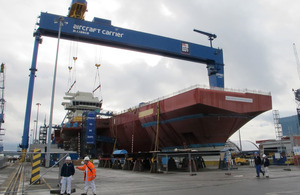
The 700-tonne navigation bridge of HMS Queen Elizabeth
is lowered into place at Rosyth shipyard in Scotland
[Picture: Copyright Aircraft Carrier Alliance]
14 March 2013 Ministry of Defence - Defence Equipment and Support
The Defence Secretary was in Scotland today to watch an enormous bridge section fitted to the Royal Navy's new aircraft carrier.
During a visit to Rosyth shipyard, Mr Hammond oversaw the 700-tonne section being lifted into place on the deck of HMS Queen Elizabeth.
Nearly two thirds of the ship has now been built and the structure is due to be completed by the end of this year. The carrier is then expected to leave the dockyard in 2014 before beginning sea trials with the Royal Navy.
The forward island, fitted today, houses the bridge where the captain and navigation crew will operate. The enormous steel section was built in Portsmouth and transported by barge to Fife, where the carriers are being assembled. Both HMS Queen Elizabeth and her sister ship, HMS Prince of Wales, will have 2 island sections which will provide independent control of navigation and air traffic control operations.
The construction and assembly of the Royal Navy’s carriers is one of the UK’s biggest engineering projects. Work on the carriers in Scotland is worth around £1.3 billion and more than 2,000 staff working on the ships in Rosyth.
Defence Secretary Philip Hammond said:
The addition of the navigation bridge is a significant milestone for HMS Queen Elizabeth, which is now entering the final months of her construction. The workforce at Rosyth should be proud of their involvement in developing the largest and most technologically advanced warships the UK has ever had.
The Queen Elizabeth Class of carriers will be in service for up to 50 years, providing the Royal Navy with highly versatile and potent capability that will enable the UK to project its power and carry out a wide range of tasks around the world. Our operational Lightning II Jets are due to arrive in 2016, a year before the HMS Queen Elizabeth sea trials, and the first flights off her deck will start in 2018.
When construction work on HMS Queen Elizabeth is completed, the blocks of HMS Prince of Wales, which are being built at shipyards across the UK, will begin to be assembled at the dockyard at Rosyth.
In a speech in Edinburgh earlier in the day Mr Hammond outlined the commitment to the UK Defence footprint in Scotland outlined in last week’s basing plan.
This plan demonstrates our continuing commitment to Scotland and to the UK Defence footprint in Scotland,” he said. “In fact, military posts in Scotland are set to be at their highest level since 2007 and Scotland will be home to one of the UK’s 3 main naval bases; our entire submarine fleet; one of its 3 main fast jet operating bases; as well as one of the Army’s Adaptable Force brigades.
These are clear signs of our commitment to Scotland’s continued role in UK Defence and they provide certainty to our Armed Forces personnel, their families and the communities in which they will be based.

Mar 14, 2013 ASDNews Source : Indra
Equipped with a complete system for detecting and analysing chemical biological radiological and nuclear agents
Indra has completed the development of a vehicle for recognising Chemical, Biological, Radiological and Nuclear threats, in addition to improvised explosives (NRBCe).
The system allows specialised staff to travel to contaminated areas so they may perform tasks for detecting and identifying possible contaminant agents in safe conditions. This R&D project has been backed by the CDTI.
Using a commercial van as the platform, Indra has created a secure work area for two operators, an operations chief and the driver. The vehicle is pressurised, and in the event of an accident that affects its habitability, an oxygen mask system connected to the filtering device makes it possible to breathe clean air.
14/03/2013 Marine nationale
Dans la nuit du 12 au 13 mars, le groupe amphibie déployé pour la mission Jeanne d'Arc 2013, composé du bâtiment de projection et de commandement (BPC) Tonnerre et de la frégate anti-sous-marine (FASM) Georges Leygues, a croisé le groupe-école allemand, composé du ravitailleur Frankfurt-am-Main et des frégates Bremen et Emden, au large du Portugal.
Les cinq bâtiments de combat ont mené un entraînement de lutte antinavire, dont l’objectif était de tester l’interopérabilité des systèmes de détection et de communication. Situés à plus de 150 nautiques l’un de l’autre, les deux groupes ont procédé à des échanges d’informations afin de construire une situation maritime commune. Puis ils se sont entraînés à réagir ensemble face à une menace simulée.
L’enseigne de vaisseau allemand Hanna Lootens, de la promotion 2010 de l’École navale française, a participé aux manœuvres depuis le central opérations du Tonnerre. Elle fait partie des 133 officiers-élèves qui participent à la mission Jeanne d’Arc.
Ces échanges sont une occasion d’illustrer les liens privilégiés qu’entretiennent les deux marines alliées, à l’heure où la France et l’Allemagne célèbrent le cinquantième anniversaire du Traité de l’Elysée qui scellent leur amitié.
En fin d’entraînement, après s’être mutuellement saluées, chacune des formations a repris sa route. Alors que le groupe allemand fait route vers le nord, le groupe amphibie de la mission Jeanne d’Arc poursuit vers la Méditerranée, où l’attendent de prochaines manœuvres opérationnelles interarmées et interalliées.
Mar 14, 2013 ASDNews Source : Airbus
Military certification and first delivery to follow soon
Airbus Military has today received full Type Certification for the A400M new generation airlifter, marking a critical step towards delivery of the first aircraft to the French Air Force.
Award of the Type Certificate makes the A400M the world’s first large military transport to be designed and certified to civil standards from its inception. Military Initial Operating Clearance is ongoing, paving the way towards first delivery.
The Type Certificate, was presented to Airbus Military by European Aviation Safety Agency (EASA) Certification Director Dr. Norbert Lohl.
Airbus Military CEO Domingo Ureña Raso said: “I would like to thank everyone in Airbus, Airbus Military and at EASA who has worked so hard to achieve this certification. It is an enormously gratifying moment to have confirmation that the A400M has fully demonstrated its compliance with the most stringent airworthiness standards. This is an aircraft that is going to transform the military airlift world in the years ahead and we look forward with great excitement to the first delivery.”
Cedric Gautier, Airbus Military Head of A400M programme, said: “Certifying the A400M to civil as well as military standards has been a huge challenge for us, our suppliers and EASA itself. But by providing a firm framework for certification from day one, to globally accepted standards, both we and the operators will see important benefits as the aircraft matures in service and new customers join the programme.”
During the certification programme the A400M has undergone exhaustive testing of its handling qualities throughout the flight envelope in normal and failure conditions; demonstrated outstanding performance in the heat of the Gulf, cold of Sweden and Canada, and at the high altitude of La Paz, Bolivia; and satisfactorily completed more than 300 hours of function and reliability testing to demonstrate the robustness of its TP400 engines and systems.
Additionally it has begun tests of more advanced military functions such as air-to-air refuelling, air-dropping of supplies and paratroopers, and low-level flight – all with highly encouraging results. The five-strong fleet of “Grizzly” development aircraft has now completed some 4,800 hours in the air during more than 1,600 flights and will continue intensively to expand the A400M’s military capabilities.
14.03.2013 Aerobuzz.fr
Qu’est le plus important des deux dans la vie d’un aéronef : son premier vol ou sa certification ? Le premier vol de l’A400M a eu lieu, après de longues années de tergiversations politico-économiques, le 11 décembre 2009. La certification vient d’être délivrée par l’EASA, le 13 mars 2013. Ce coup de tampon est plus qu’une formalité administrative.
Avec cette certification, l’A400M devient, en effet, le premier grand avion de transport militaire au monde conçu et certifié aux normes civiles dès sa création. La certification au standard militaire IOC (Initial Operating Capability) est en cours, ouvrant ainsi la voie à la première livraison, prévue en 2013. Le premier A400M entrera ensuite en service dans l’Armée de l’air française.Ce sera aussi une étape hautement symbolique.
13 mars 2013 Romandie.com (AFP)
FRANCFORT - L'Autorité européenne de sécurité aérienne (AESA), à Cologne (ouest), a annoncé mercredi avoir délivré un certificat qui permettra à l'avion de transport militaire A400M de s'insérer dans le trafic aérien civil.
L'A400M est le premier transporteur à turbopropulseur dans sa catégorie à recevoir la certification de l'AESA. Je suis très fier de ce succès, qui est le fruit de la coopération entre l'AESA et les équipes militaires d'Airbus, a déclaré le directeur du département certification de l'AESA, Norbert Lohl, cité dans un communiqué publié en fin d'après-midi.
L'A400M avait reçu une première certification de l'AESA en avril 2012, mais la certification complète était attendue à l'issue des 300 heures d'essais de fonctionnalité et de fiabilité.
Le premier exemplaire de cet avion doit être livré à la France d'ici la mi-juin, après des années de gestation douloureuse.
Airbus Military a reçu aujourdhui le certificat de type complet pour son avion de transport de nouvelle génération A400M, franchissant ainsi une étape essentielle vers la livraison du premier appareil à larmée de lAir française, a commenté pour sa part le groupe, dans un communiqué séparé.
Avec cette certification, lA400M devient le premier grand avion de transport militaire au monde conçu et certifié aux normes civiles dès sa création, a ajouté Airbus, soulignant que la certification au standard militaire IOC (Initial Operating Capability) est en cours.
Pour Cédric Gautier, chef du programme A400M chez Airbus Military, la certification de lA400M à la fois aux normes civiles et militaires a constitué un défi de taille pour nous, nos fournisseurs et lEASA (AESA). Toutefois, en proposant dès le premier jour un cadre fixe de certification aux normes acceptées par tous les acteurs, les opérateurs bénéficieront tout comme nous davantages importants à mesure que lavion évoluera en service et que de nouveaux clients rejoindront le programme.
Dessiné à la demande des états-majors européens après la première guerre du Golfe de 1991, qui avait mis en évidence leur manque de moyens, l'A400M doit remplir des missions stratégiques (transport sur de très longues distances) et tactiques.
Equipé de quatre turbopropulseurs, il sera capable de transporter jusqu'à 37 tonnes sur 3.300 kilomètres, et de se poser au plus près des combats, sur des terrains non préparés, même dans le sable, avec des blindés ou des hélicoptères. Il est aussi conçu pour larguer des parachutistes des forces spéciales à 12.000 mètres d'altitude ou ravitailler en vol deux avions ou deux hélicoptères.
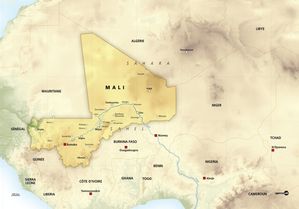
13.03.2013 LE MONDE
On ne voudrait pas ajouter au désenchantement européen. En ces temps de grosse déprime continentale, on rechigne à l'idée de mettre une nouvelle fois à nu la vacuité qui caractérise aujourd'hui l'idée européenne. Bref, on hésite avant de jouer encore les esprits chagrins en constatant la désespérante absence de l'Europe au chapitre de la défense et des affaires étrangères.
Ce n'est pas un échec - lequel supposerait qu'on ait sincèrement essayé -, c'est une débâcle, une triste pantalonnade. Le Mali en témoigne, magistralement. Et ce fut tout particulièrement le cas lors du conseil des 27 ministres des affaires étrangères réuni lundi 11 mars à Bruxelles. La France s'y est sentie plus seule que jamais depuis le début des opérations militaires au Sahel.
Avec la fermeté courtoise, un tantinet distante, qui est sa marque, Laurent Fabius en fut réduit à quémander 30 soldats pour le Mali auprès de la Belgique et de l'Espagne. Pas 300, 30 ! Pourquoi ? Parce qu'il en manque encore 90 pour protéger les 500 instructeurs que l'Union européenne a dépêchés à Bamako pour former l'armée malienne.
Ces 90 soldats, il faut les "arracher" un par un aux 27 pays de la riche Europe, celle qui se targue volontiers d'être l'une des toutes premières puissances économiques mondiales. Disons les choses comme elles sont : les réticences belges ou espagnoles ne sont pas d'ordre politique ni même financier. C'est bien plus simple : Bruxelles et Madrid se fichent éperdument de ce qui peut bien se passer dans les sables du Sahel.
L'hypocrisie triomphe. Sur le papier, les Vingt-Sept sont d'accord. La stabilité de l'Afrique dépend très largement de l'extinction du foyer djihadiste qui se propage au Sahel, disent les Européens ; il en va aussi de la sécurité de l'Europe, si proche et si vulnérable, au terrorisme islamiste, ajoutent-ils.
Mais ce ne sont que des mots. Quand il faut agir ensemble, il n'y a plus personne ou presque. Certes, Paris a eu le tort, au départ, de lancer ses troupes sans consultation avec ses partenaires. Mais il eût fallu ensuite une vraie solidarité européenne, l'affichage d'un intérêt commun, défendu ensemble - en somme, un partage du fardeau qui devra être porté à l'avenir. Il eût fallu manifester une présence forte de l'Union dans cette partie du monde, sauf à laisser la Chine, les Etats-Unis ou d'autres devenir les partenaires privilégiés des Africains au XXIe siècle.
Hélas, l'Europe n'affiche que désunion pathologique et pingrerie aveugle. Seuls cinq pays sur vingt-sept sont vraiment engagés dans la mission de formation de l'armée malienne. Au-delà des déclarations sentencieuses sur la nécessité d'un "plan de stabilisation politique et économique du Sahel", la réaction à peine voilée de la plupart des 27 aux événements du Mali tient en une phrase : "Que la France se débrouille !" Et tant pis pour la contradiction qu'il y a à soupçonner les Français de velléités postcoloniales et de les laisser en première ligne dans l'Afrique francophone...
L'Europe fuit l'Histoire. Elle le paiera, un jour.
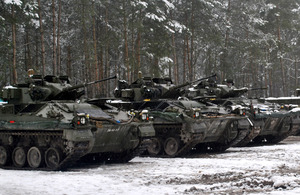
Warrior armoured vehicles waiting to start live firing
[Picture: Crown copyright]
13 March 2013 Ministry of Defence
Soldiers from 5th Battalion The Rifles (5 RIFLES) have spent 3 weeks training with Warrior infantry fighting vehicles on Sennelager Training Area as part of one of the largest armoured deployments in recent years.
In light of the Army 2020 announcement, 5 RIFLES have been training hard to bring their core skills as an armoured infantry unit back up to scratch after their recent deployment to Afghanistan.
In their future role, as part of the UK’s reactive forces, 5 RIFLES will be at the forefront of any future armoured deployment.
As a result, this training has been designed to ensure the battalion’s primary skill set operating as infantry from armoured vehicles is at the highest standard for any future operations.
The exercise, which was conducted in sub-zero temperatures, covered dry training and live firing in the mounted, dismounted and integrated roles within a ‘return to contingency’ scenario.
The exercise saw 484 Riflemen deploy onto Sennelager Training Area in Germany where they lived out of their armoured vehicles - of which 99 deployed in total.

The aim of the exercise was to prepare the battalion for the forthcoming exercise Bavarian Charger which will take place in Bavaria in June.
But more importantly it allowed the Riflemen to get used to fighting from, living off and maintaining their vehicles after their recent deployment as a ground-holding battle group in Afghanistan.
Captain Iain Hardman said:
Training in Sennelager has been extremely useful for the battalion after our recent tour of Afghanistan. Although we have not operated from armour in a while, it didn’t take us long to get back into the swing of things.
This is the most thorough level one collective training exercise I have been on and I am confident we are not only ready for our level three collective training exercise in Bavaria but also for any challenges the future may hold.
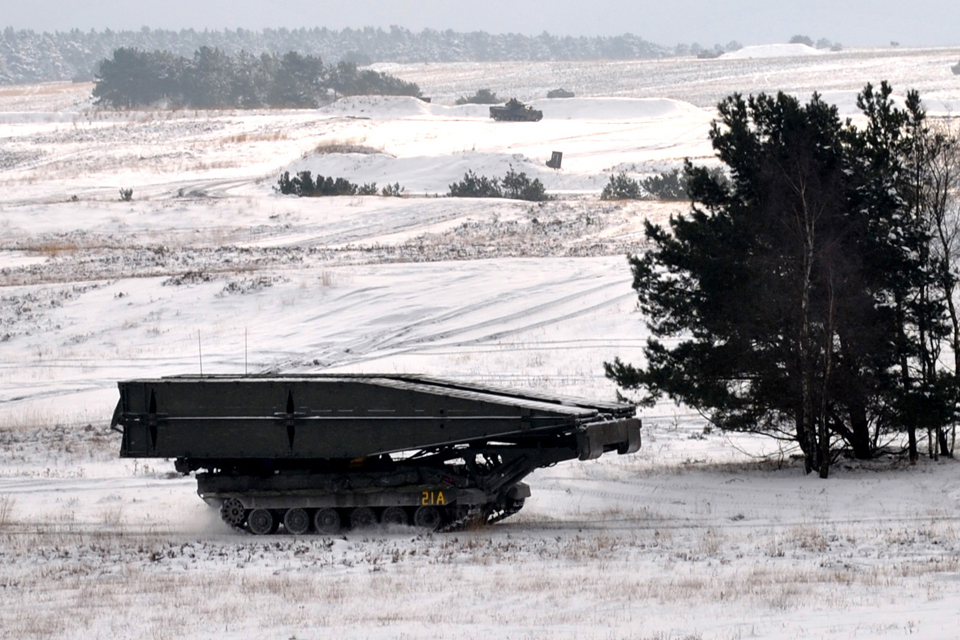
The highlight of the exercise was a manoeuvre called an ‘obstacle crossing’ which involves armoured vehicles crossing a river or a gap with combat bridging mounted on an armoured engineer vehicle.
Challenger 2 tanks from C Squadron of the Queen’s Royal Hussars were also used to provide ‘overwatch’.
Lieutenant Colonel Charles Collins, Commanding Officer of 5 RIFLES, said:
This has been a useful field exercise for the whole battalion in order to deliver platoon-level training. The Riflemen have got used to living off, caring for and fighting from their armoured vehicles over a 3-week period in sub-zero temperatures.
Each level has been tested, from fire team to company headquarters to our logistic echelons, and we are now in a better position for exercises in Bavaria and Canada later in the year as well as for any return to contingency and our armoured infantry future under Army 2020.
5 RIFLES are an armoured infantry battalion based in Paderborn in Germany and are part of 20th Armoured Brigade. Under the recent rebasing announcement they will be based in Bulford from 2016.
08.03.2013 club-participation-progres
12/03/2013 Michel Cabirol - latribune.fr
Tom Enders a nommé à partir du 1er avril un Français - Guillaume Faury - à la tête d'Eurocopter, à la place de Lutz Bertling, attiré par les sirènes très convaincantes du groupe canadien Bombardier.
Chez EADS, le passeport n'est plus vraiment nécessaire pour prendre un poste de patron, seules les compétences comptent. Tom Enders vient de le prouver à nouveau en nommant à partir du 1er mai un Français à la tête d'Eurocopter, Guillaume Faury, à la place de Lutz Bertling, attiré par les sirènes très convaincantes du groupe canadien Bombardier. Il en avait auparavant avisé le gouvernement allemand. Après Fabrice Brégier à la tête d'Airbus, les Français récupèrent un autre poste clé, celui d'Eurocopter.
Pourquoi un départ de Lutz Bertling ? L'actuel patron du constructeur d'hélicoptères quitte la France et prend le train pour l'Allemagne où il a été nommé patron de Bombardier Transport, la division ferroviaire du groupe canadien Bombardier. A 50 ans, Lutz Bertling, qui est à la tête de la filiale Eurocopter depuis novembre 2006, "a récemment exprimé le souhait de quitter le groupe pour poursuivre sa carrière professionnelle en Allemagne". Outre sa nomination chez Bombardier, des raisons personnelles l'ont également convaincu de s'installer à Berlin, où se trouve le siège social de Bombardier Transport. "Je regrette le départ de Lutz d'Eurocopter et du groupe EADS pour poursuivre de nouveaux défis en dehors du monde aérospatial, a expliqué le président exécutif d'EADS, Tom Enders. Nous lui devons beaucoup. Durant six ans et demi à la tête d'Eurocopter, il a su piloter l'entreprise avec succès à travers une période marquée à la fois par une forte croissance et une profonde crise économique internationale. Au cours de son mandat, Eurocopter est devenu plus international et innovant, et globalement plus compétitif".
Retour d'un ancien grand espoir d'Eurocopter
Le départ de Lutz Bertling coïncide avec le retour d'un ancien grand espoir d'Eurocopter, Guillaume Faury, parti d'abord chez Segula Technologies (janvier 2009) puis très rapidement nommé chez PSA Peugeot Citroën (mars 2009). A l'époque, certains avaient beaucoup regretté son départ imputé à Lutz Bertling. Son retour devrait ravir les syndicats français. "Grâce à son intime connaissance d'Eurocopter, ses qualités de leadership et sa large expertise industrielle, Guillaume Faury est assurément la bonne personne pour conduire les ambitions d'Eurocopter en matière d'innovation et de positionnement mondial", a fait valoir Tom Enders.
Clairement, Eurocopter a besoin de ses compétences pour maîtriser une phase délicate pandant laquelle plusieurs programmes vont être lancés ou sont en cours de développement. Chez Eurocopter, il avait occupé les postes de vice-président exécutif des programmes commerciaux, puis vice-président exécutif pour la Recherche & Développement. En outre, en tant qu'ancien patron du programme EC225/725, dont la version civile (EC225) rencontre aujourd'hui de graves difficultés techniques, il devrait prendre les décisions adéquates pour remettre en vol ce modèle cloué au sol en Grande-Bretagne pour le transport de personnes sur les plates-formes offshore, notamment.
Vol en patrouille illustrant la coopération franco-allemande
12/03/2013 Armée de l'air - Economie et technologie
Les 6 et 7 mars 2013, le général Guillaume Gelée, commandant les forces aériennes (CFA), s’est rendu sur la base aérienne de Nörvenich près de Cologne (Allemagne) à l’invitation de son homologue, le Generalleutnant Peter Schelzig, à la tête du Luftwaffenführungskommando (LwFüKdo).
Les deux généraux, responsables de l’entrainement des forces et de la formation spécialisée au sein des armées de l'air allemande et française ont évoqué la coopération franco-allemande dans le domaine aérien. Ils ont notamment abordé la préparation aux opérations sur le théâtre malien, où l’Allemagne a récemment renforcé son dispositif en déployant au profit de la MISMA (Mission internationale de soutien au Mali, sous conduite africaine), un Airbus A310 MRTT (Multirole Transport Tanker) en plus des deux Transall déjà sur la zone.
Dans le ciel de Cologne au départ de la base de Norvenich, le général Schelzig a pu découvrir, lors d’un vol en Rafale, les capacités opérationnelles « multirôle » du chasseur français. Son pilote pour cette occasion, le commandant Thierry Kubiak, commandant l’escadron de transformation Rafale (ETR) 2/92 "Aquitaine" stationné sur la base aérienne 113 de Saint-Dizier, un des pilotes les plus expérimentés sur la machine, lui a montré la polyvalence du chasseur actuellement engagé dans les opérations au Mali.
Ces rencontres régulières entre les deux grands commandements s’inscrivent cette année à l’occasion du cinquantenaire du traité de l’Élysée signé entre le général de Gaulle et le chancelier Adenauer. Les deux pays ont remis en février dernier les premiers brevets de contrôleurs aériens avancés dont l’action est indispensable dans la conduite des opérations aéroterrestres, comme celles qui se déroulent actuellement dans le cadre de l’opération Serval.
Le général Peter Schelzig en compagnie de son pilote le commandant Thierry Kubiak
Les deux généraux sont responsables de l’entrainement des forces et de la formation spécialisée au sein des armées de l'air allemande et française.
12/03/2013 Sources : EMA
Le 6 mars 2013, l’amiral Edouard Guillaud a reçu le général Mieczyslaw Cieniuch, chef de l’état-major général des armées polonaises dans le cadre d’une visite officielle.
Cette rencontre a été l’occasion de faire le point sur les grands sujets internationaux et sur l’engagement des deux pays au sein de l’Alliance atlantique et dans le cadre de la politique de sécurité et de défense européenne.
Deux semaines après la réunion des ministres de la défense de l’OTAN (21-22 février), le général Cieniuch a souligné l’importance du prochain entrainement majeur de l’OTAN, dans la zone polono-balte.
Le CEMA polonais a également rappelé l’implication de la Pologne dans la construction de la défense européenne, alors même que se tenait à Varsovie le premier sommet de « Visegrad + » élargi à la France et à l’Allemagne. Il s’agissait de la première participation française à un sommet de cette instance qui, depuis février 1991, réunit quatre pays d’Europe centrale (Pologne, Slovaquie, Hongrie, République Tchèque).
Cet entretien a naturellement permis un échange sur la situation au Mali. A cette occasion, le CEMA polonais a confirmé son soutien à l’opération Serval et à la mission européenne de formation EUTM Mali. D’autres sujets comme l’Afghanistan ou la Syrie ont également été abordés au cours de cet entretien.
La coopération militaire et de défense constitue un élément structurant de la relation franco-polonaise en bilatéral comme dans le cadre européen et atlantique. Cette coopération fait partie du partenariat stratégique signé le 28 mai 2008 et concerne principalement la formation (échanges d’élèves-officiers), les exercices multilatéraux (Steadfast Jazz en 2013) et le partage d’expérience, notamment sur la préparation et l’engagement des forces sur des théâtres extérieurs. Cette relation bilatérale militaire, portée par une ambition commune, vise à renforcer l’interopérabilité de nos forces souvent engagées en coalition sur les mêmes théâtres d’opération.
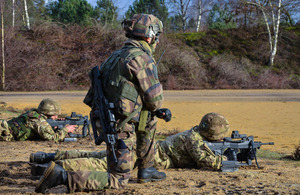
British and French marines taking part in Exercise
Gaelic Venture [Picture: Crown copyright]
12 March 2013 Ministry of Defence
Royal Marines from the West Country recently crossed the Channel to take part in an exercise with their French colleagues.
Members of M Company of 42 Commando, based in Plymouth, took part in Exercise Gaelic Venture - a joint Anglo-French exercise conducted between 3 Commando Brigade and the French 9th Light Armoured Marine Brigade.
Both are infantry units which form part of their respective country’s navies.
The exercise saw M Company deploy to Le Mans with France’s 2nd Marine Infantry Regiment, with the aim of building on existing Anglo-French military relations and developing an understanding of the different operating procedures.

These joint exercises are increasingly important as Britain and France strengthen their military ties.
With most of the 2nd Marine Infantry Regiment deployed to Mali, the exercise involved M Company working with the French 4 Company around Camp d’Auvours.
A 20-kilometre ‘yomp’ preceded communications testing (which was a challenge with 2 languages involved) before the British and French companies set themselves up in harbours and conducted reconnaissance of the area, culminating in a simultaneous assault on 2 ‘enemy’ strongholds.

The officer commanding the Royal Marines took command of a platoon of French marines whilst a troop of Royal Marines deployed into the field as part of the French company.
Having only 1 French speaker in the troop proved a challenge, but demonstrated that language is not the main barrier for joint operations.
A spokesman for 42 Commando said:
Once the attacks were over the Royal Marines established themselves on the ‘enemy’ positions overnight.
We proved ourselves an impressive surveillance asset throughout, surprising our French hosts as we routinely contacted counter-attacks before they had even successfully located our harbour!

The final day was spent on a firing range and doing some French-led physical training which the Royal Marines devoured.
After the exercise the Royal Marines went on a 2-day battlefield tour of Normandy to sites of several key Second World War amphibious actions, including Port-en-Bessin and where US Rangers conducted a cliff assault on enemy gun emplacements.

12.03.2013 IRSEM
L'évolution du contrôle parlementaire des forces armées en Europe
Par Bastien IRONDELLE, Olivier ROZENBERG, Catherine HOEFFLER, Jean JOANA, Olivier CHOPIN, Christian OLSSON
Depuis plusieurs années, la question du contrôle parlementaire des forces armées est devenue en Europe un enjeu important du débat public et politique. L’attention s’est notamment portée sur le contrôle des opérations extérieures et du renseignement, qui ont donné lieu à plusieurs initiatives parlementaires depuis la fin des années 1990 : rapports, projets de loi, missions d’information.
Mais ce contrôle est désormais soumis à d’importantes mutations. Certaines ont trait à l’évolution des forces armées et de leurs missions, notamment l’internationalisation des usages de la force armée dans le cadre d’alliance ou d’opérations en coalition. D’autres sont liées à l’évolution plus fondamentale du Parlementarisme en Europe, généralement centrée sur la thématique du déclin des assemblées législatives face à la montée en puissance des exécutifs. Ces dynamiques affectent négativement les capacités de contrôle du Parlement sur les armées et la politique de défense alors même qu’elles en renforcent la nécessité.
À partir d’une vaste étude à la fois quantitative (questions au gouvernement) et qualitative (entretiens au sein des commissions parlementaires) menée au Royaume-Uni, en Allamagne, en Espagne, en Suède et en France, Bastien Irondelle, Olivier Rozenberg, Catherine Hoeffler, Jean Joana, Olivier Chopin et Christian Olsson montrent comment les Parlements cherchent à renforcer leurs fonctions de contrôle du gouvernement et de l’exécutif dans une Europe en pleine mutation face à l’usage de la force.
Cette étude a été réalisée par Bastien IRONDELLE (Sciences Po), Olivier ROZENBERG (Sciences Po), Catherine HOEFFLER (Université Montpellier 1), Jean JOANA (Université Montpellier 1), Olivier CHOPIN (EHESS) et Christian OLSSON (Université Libre de Bruxelles).

MIDCAS, an EDA sponsored €50 million industry project to develop advanced collision-avoidance abilities for remotely piloted aircraft systems (RPAS), will see its first demonstration flight by summer 2013.
MIDCAS provides a cornerstone solution for the integration of RPAS in non-segregated airspace. The MIDCAS industry consortium is composed of 13 companies of the five participating Member States: France, Germany, Italy, Spain and Sweden (lead nation). Launched in September 2009, the project’s main principles are standardisation support, systems engineering, functional design, demonstrator design, tests & evaluation, as well as safety.
The developed detect and avoid demonstrator will be tested on a conventional manned aircraft in France before summer 2013. In the first half of 2014 the MIDCAS demonstrator will be tested and validated on board of an unmanned demonstrator aircraft. This RPAS flying campaign will take place in Sweden.
The project is significantly supported by the stakeholder community to ensure a harmonised transition from project result to a detect and avoid standard.
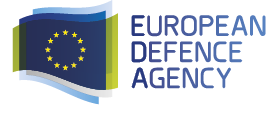
12 Mars 2013 - RIA Novosti
L'Estonie, la Lettonie et la Lituanie ont annoncé, lors d'une réunion de l'Agence européenne de Défense (AED) à Bruxelles, leur volonté commune d'organiser un appel d'offres afin d'acheter des munitions à hauteur de 50 millions d'euros, annonce mardi le service de presse du ministère estonien de la Défense.
Selon ce dernier, il s'agit d'acheter des munitions pour les lance-roquettes antichar Karl Gustav. L'Estonie veut acquérir des munitions tant pour les exercices militaires que pour se reconstituer un stock en cas de guerre.
Le vice-chancelier du ministère estonien de la Défense Ingvar Pärnamäe a affirmé que pour les pays Baltes, il s'agissait du premier achat de munitions par l'intermédiaire de l'Agence européenne de défense. Il a ajouté que l'Agence se chargeait d'organiser l'appel d'offres et qu'il ne resterait aux pays Baltes qu'à choisir la meilleure proposition.
Mar 12, 2013 defense-aerospace.com
(Source: Diehl Defence; issued March 11, 2013)
Diehl Receives from Sweden Contract for Air Defence
The Swedish Defence Material Administration signed a contract with Diehl Defence to deliver IRIS-T SLS surface-to-air missile (SAM) systems for the country’s armed forces.
The new units comprising the IRIS-T missile, missile launching station and fire control system are to improve the national air defence by protection against air attacks from a large variety of threats including missiles, helicopters and aircraft.
Following deployment, the mobile system allows fully automatic operation 24 hours a day. The Swedish Army will operate the SAM fire units, together with a new Command and Control System as well as modernized sensors from Saab.
IRIS-T SLS employs the standard IRIS-T air-to-air missile and is the short-range complement to the medium-range IRIS-T SLM ground-based air defence system of Diehl Defence.
With the IRIS-T SLS/SLM ground-based air defence systems, Diehl is setting new standards in open system design architectures providing maximum flexibility for new weapon systems as well as for the modernization/upgrade of legacy equipment. IRIS-T SLM is based on the SAM system development in Germany for national air defence.
Delivery of the first IRIS-T SLS systems is scheduled to commence in 2016. As partner of the European missile program, Sweden has already introduced the IRIS-T air-to-air missile for its Gripen fighter aircraft.
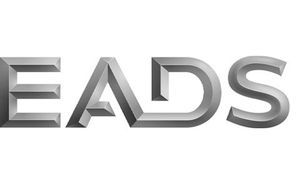
Amsterdam, 12 March 2013 EADS
The EADS Board of Directors has accepted the resignation of Lutz Bertling as Chief Executive Officer of Eurocopter and Member of the EADS Group Executive Committee, effective 30 April 2013.
Bertling, 50, has been at the helm of the Group’s helicopter Division since November 2006 and had recently expressed his desire to depart the Group in pursuit of another professional opportunity in Germany.
The EADS Board of Directors has appointed Guillaume Faury, 45, to succeed Lutz Bertling. Effective 1 May 2013, Faury joins Eurocopter from Peugeot S.A., where he has served as Executive Vice President for Research & Development since 2010 and as Member of the Managing Board since 2009.
“I regret that Lutz is leaving Eurocopter and the EADS Group to pursue a new challenge outside the aerospace world. We owe Lutz a lot. In his six and a half years at the helm of Eurocopter, he led the company successfully through a period of strong growth and also a deep economic crisis. During his tenure Eurocopter became more international, more innovative, and overall, more competitive. I thank him for all his work and wish him the best for his future”, said Tom Enders, Chief Executive Officer of EADS.
“I am happy to welcome Guillaume Faury back at EADS. Early in his career, he excelled at Eurocopter in various management positions before accepting a very senior role at Peugeot. With his profound knowledge of the Division, his leadership skills, and his broad industrial expertise, I am convinced Guillaume is the right person to drive Eurocopter’s ambitious innovation roadmap and global positioning,” Enders said.
Faury, a licensed flight test engineer, served in various senior management functions at Eurocopter from 1998 to 2008 before joining Peugeot S.A. He was Chief Engineer for the EC225/ 725 programme, Head of the Heavy Helicopter Flight Test department, Executive Vice President for Commercial Programmes and, ultimately, Executive Vice President for Research & Development. Faury also was a member of the Eurocopter Executive Committee. He started his professional career with the French Defence Procurement Agency DGA, where he was in charge of Tiger helicopter flight test activities at the Istres Flight Test Centre. Faury holds an engineering degree from the Ecole Polytechnique in Paris as well as an aeronautics and engineering degree from the Ecole Nationale Supérieure de l’Aeronautique et de l’Espace in Toulouse.
About EADS
EADS is a global leader in aerospace, defence and related services. In 2012, the Group – comprising Airbus, Astrium, Cassidian and Eurocopter – generated revenues of € 56.5 billion and employed a workforce of over 140,000.